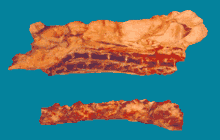Cutting
When we were children, whilst our mothers bought brains or chops, we used to study the poster ¾always blue¾ that illustrated the names and shapes of the pieces resulting from cutting up a sheep or a pig.
Memorising all the parts and their location was useful knowledge for the life of the meat consumer. It enabled us to know the parts, not the whole, as the nature of cut-up animal was always lacking from the puzzle, the full, healthy image we always found in children's books: the cow moos (it always looked serious), the pig lives in the sty (it was always smiling). Looking at the cut-up pieces of meat, intuition told us the whole is greater than its parts, and so we saw the cow, but could not find it.
More than one childish mind must have taken its first metaphysical flight in a butcher's shop, for the good butcher shook us with a sliced-up truth that consisted either of witnessing what a cow really was or what a cow really was not, even today I am not sure which.
As chess players know, moving a piece can cause one's opponent to tremble.
Now, where the old poster once spoke of the metaphysical cow, we have the human body cut into pieces. Someone has moved a piece. Check.
Alberto Sampablo Lauro, Barcelona 2003
Sponsors: caja madrid obra social | ràdio4 | el país
Colaborators: fujifilm | schilling cafè





